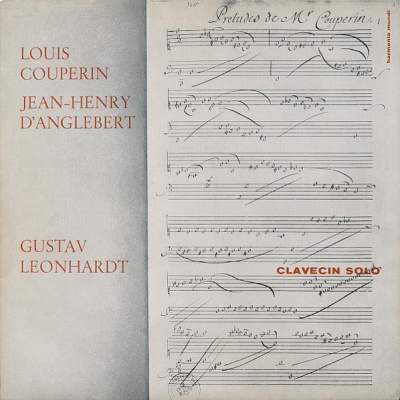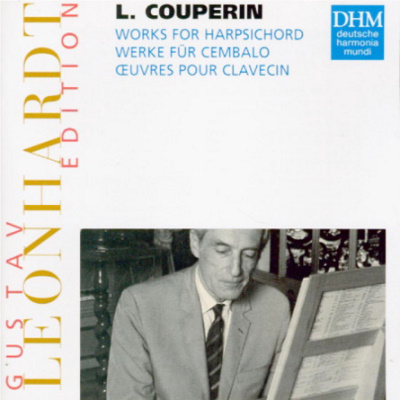 |
|
1 LP -
HM 30 647 - (p) 1963
|
 |
| 1 CD -
74321 32326 2 - (c) 1995 |
|
CLAVECIN SOLO
|
|
|
|
|
|
|
|
| Louis COUPERIN (1626-1661) |
Suite
in d |
|
18' 47" |
A1 |
|
-
Prélude · Allemande · Courante I and
II · Sarabande · Canaries ·
Pastourelle · Chaconne |
|
|
|
|
Tombeau de M.
Blancrocher
|
|
4' 35" |
A2
|
| Jean-Henri
d'ANGLEBERT (1635-1691) |
Suite
in g |
|
19' 52" |
A3 |
|
- Prélude ·
Sarabande-Lentement · Gigue ·
Gaillarde-Lentement · Menuet de
Poitou · Vaudeville · Passacaille |
|
|
|
|
Tombeau
de Mr. de Chambonnières |
|
4' 25" |
A4 |
|
|
|
|
|
Gustav Leonhardt,
Harpsichord (Martin Skowroneck, Bremen
1962, nach einem Instrument von J. D.
Dulcken, Antwerpen 1745)
|
|
|
|
|
|
Luogo
e data di registrazione |
|
Schloß Ahaus in
Westfalen (Germany) - giugno 1963 |
|
|
Registrazione: live
/ studio |
|
studio |
|
|
Recording
Supervision |
|
Dr. Alfred Krings
|
|
|
Engineer |
|
Hubert Kübler |
|
|
Prima Edizione LP |
|
Harmonia Mundi | HM
30 647 | 1 LP - durata 47' 39" |
(p) 1963
|
|
|
Edizione CD |
|
Deutsche Harmonia
Mundi | LC 0761 | 74321 32326 2 |
1 CD - durata 76' 30" | (c) 1995 |
ADD | Only Louis Couperin
|
|
|
Cover Art
|
|
-
|
|
|
Note |
|
-
|
|
|
|
|
The undisputed
leadership of France in the
field of harpsichord music
embraces a period of about
one hund red years (ca. 1650
- ca. 1750). This is
certainly remarkable, in
view of the fact that before
this time the harpsichord
occupied but a modest place
in French social life. The
favourite instrument was the
lute, which was easier to
manage but more difficult to
play. Many French harpsichor
pieces clearly show that the
art of "clavecin" arose from
lute music. This is
especially true of the early
masters whose works, ousted
after 1700 by the
gracefulness and brilliance
of François Couperin le
Grand and Rameau, have
fallen unjustly into
oblivion.
Two of these early
harpsichordist are
represented on this record:
Louis Couperin and
Jean-Henry d'Anglebert.
Following the custom of
their time, they grouped
their pieces according to
key. It was left up to the
player to form a suite by
choosing a number of dances,
and this Mr. Leonhardt has
done. Several movement
require some commentary.
Both "préludes" are of the
"non mesuré" type. Written
almost entirely in
semibreves without time
signature and regular
barring, they leave the
shaping of the rhythm to the
performer. The French
"chaconne" does not consist
of the usual series of
ostinato variations, but is
a stylized dance originating
from the "ballet de cour"
and composed in the form of
a "rondeau". The "canaries"
is a dance musically related
to the gigue. Finally, the
"tombeau" gives us a glimpse
into 17th century social
life. It is an expressive
piece of music written to
the memory of a decessed
person, usually a friend of
the composer. The "tombeau"
played on this record honor
famous musicians:
Blancrocher, a lutenist
whose works are lost, and
Champion de Chambonnières,
founder of the French
harpsichord school and
former teacher of both Louis
Couperin and d'Anglebert.
The masters of the
seventeenth century wrote in
a style less gracious than
that of the Rococo period.
Their harmonies, however,
are more spicy and their
works reflect the forceful
spirit of the "grand
siècle".
Gustav Leonhardt plays on a
harpsichord built in 1962 by
Martin Skowroneck, Bremen.
It is a replica of an
instrument made in 1745 by
J. D. Dulcken of Antwerp,
and is tuned in meantone
temperament.
Frits
Noske
|
  |
|
|